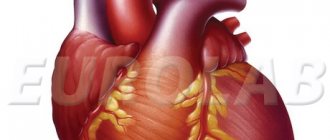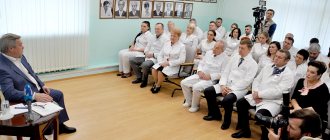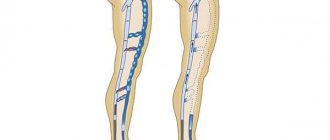Surgery to remove varicose veins on the legs (phlebectomy of the veins of the lower extremities) is one of the oldest forms of surgical treatment of varicose veins of the lower extremities. The earliest description of the procedure was written by Aulus Cornelius Celsus, a Roman medical historian. The first description of phlebectomy using hooks was published in 1545. Modern combined phlebectomy was developed around 1956 by a Swiss dermatologist named Robert Müller.
Microphlebectomy is the medical term used for the procedure of removing an enlarged superficial vein through a tiny incision in the leg. The incisions are so small that they often do not require stitches to close them. A small piece of masking tape is usually enough to cover it. The procedure also helps eliminate pain and improves the appearance of the legs. Surgery for varicose veins of the lower extremities can be used in combination with other procedures such as EVLT (endovenous laser therapy) and sclerotherapy.
Phlebologists at our center perform surgery on the legs for varicose veins, as suggested by the German professor Varadi, who developed his own instruments for performing the operation and formulated the basic postulates of modern microphlebectomy through a puncture. This method has excellent cosmetic results, is painless and does not require hospitalization. At the Innovative Vascular Center, this operation on veins for varicose veins is performed perfectly, and the price of the intervention is affordable for everyone.
How relevant, in your opinion, is surgical treatment of varicose veins today?
Phlebectomy, of course, is relevant, if only because we often encounter advanced forms of varicose veins: people do not always see a doctor on time. This is the first point. Second, surgery is necessary if the patient has certain characteristics of the veins, for example, they are very wide or very tortuous. Then it will not be possible to cure varicose veins using any other methods: neither sclerotherapy nor laser will guarantee that the lumen of the vein is completely closed.
The third important point when we can recommend surgery is a large number of lateral tributaries near the main vein. They can be removed using minimally invasive methods, but this takes a lot of time, which is difficult for the patient. It is in his interests to agree to the operation.
Contraindications
Phlebectomy is not recommended in the following cases:
- During pregnancy and lactation.
- If the patient has serious diseases of the cardiovascular system (coronary artery disease, recent myocardial infarction, stroke, heart defects with severe hemodynamic impairment).
- If the skin in the area of surgical manipulation is affected by eczema in the acute stage, purulent formations.
- In case of acute thrombosis of the superficial veins of the lower extremities, planned operations are not performed; in case of life-threatening thrombosis of the deep veins, emergency surgical interventions are performed such as crossectomy (ligation of the great saphenous vein at the point of its transition into the common femoral vein, plication (special technique for suturing veins) of the deep veins) .
- In the presence of any infectious diseases in the acute stage (ARVI, influenza)
- With exacerbation of chronic diseases.
How is phlebectomy performed?
Each operation has several stages. Crossectomy is a step where the target vein that we remove is ligated and thereby cut off from the deep venous system. Next comes the removal of the trunk - stripping. This can be a Babcock stripping, when the vein is cut out using a special probe. Cryostripping can be performed - an operation in which a cryoprobe is inserted into a vein, the vessel is “frozen” to it using nitrous oxide, and the doctor pulls it out. A distinctive feature of cryostripping is that the patient makes only one incision in the groin area. PIN stripping can also be performed, when the vein is “screwed” inward. The last two methods cause less tissue damage.
At the third stage, a miniphlebectomy is performed - the tributaries of the main vein are removed through punctures.
Very cosmetic
In most Russian hospitals, varicose veins on the legs are removed, both through a large incision in the groin (crossectomy) and through large incisions on the legs according to Narat or Linton. The consequences of such a combined phlebectomy are not satisfactory for most patients. Our technology involves minimal intervention through skin punctures that leave virtually no scars. The dilated vein is “evaporated” with a laser without incisions. Varicose veins and nodes are eliminated with microphlebetomy and Foam-Form sclerotherapy. The use of a minimally invasive technique involves significantly less tissue trauma than “classical” combined phlebectomy; patient reviews of the postoperative period are very good.
How long does the recovery period last?
Usually a week. We recommend that patients stay at home, but not in bed, but semi-active. The first three days you can spend about 40% of the time on your feet, and then you need to start “pacing.” On the seventh day, the stitches are removed and the sick leave is closed. For example, we had a patient who had surgery on both legs in turn. And once he completely went through the recovery period, and the second time he had to go to a work meeting after the operation. This leg recovered worse; there were bruises, although he tried to spare the leg and not put stress on it.
What you need to know about phlebectomy
How to prepare for surgery
It is necessary to consult a phlebologist. He will evaluate the condition of your veins, order certain tests, and determine whether the affected veins need to be surgically removed. I would like to note that varicose veins have concomitant diseases, which are extremely dangerous to turn a blind eye to. A phlebologist can arrange for you to visit a cardiologist, infectious disease specialist or allergist, who will help determine the risk of undergoing surgery with a simultaneous disease.
If everything is in order with the patient’s tests and there are no other health conditions, the patient is scheduled for surgery in the near future.
How is phlebectomy performed?
This procedure has several stages. The first stage: ligation and removal of the target vein, cutting it off from the deep veins.
Second stage: the surgeon removes the trunk by stripping. A probe is slowly inserted into the vein through a small incision, helping to accurately disconnect the affected vein and remove it. There is also a more gentle method of treating the affected vein. Using the same probe, the vein is carefully screwed into itself, so the body undergoes minor changes, but not as serious as when the vessel is removed. Another excellent method for removing the affected vessel is to insert a cryoprobe through the incision - the vein is burned with nitrogen on both sides and is also removed.
This operation has one significant advantage - to remove a vein, you no longer need to make long incisions along the lower limb; it is enough to make a small incision in the groin area, up to 3 cm in size. Sometimes, the incision is increased to 5 cm, depending on the volume of the operation .
What anesthesia is used for phlebectomy?
Typically, spinal anesthesia with sedation is used for this operation. An injection is given in the lumbar region of the back so that the legs stop feeling anything for a while. After which the patient receives an injection of sedation and falls asleep. This is significantly different from the use of general anesthesia, as it actively uses ventilation.
When can a patient feel the effectiveness of treatment?
If the patient had acute pain in the extremities before surgery, or symptoms of venous insufficiency were diagnosed, then symptoms may continue to appear for some time after phlebectomy. For now, the patient is prescribed special medications as a course of treatment. If we mean pain from vein removal, then it goes away within a few days after the operation. In the postoperative period, sclerotherapy is prescribed. It helps remove all residual “small” tributaries to the affected veins.
On average, a patient needs 1 week to recover after surgery. Home mode is recommended. It is important to note that the regime is not completely bed rest, but semi-active. Life is in motion. The sooner you start moving, the sooner you will feel the benefits of treatment. On the last day, all stitches are removed and, as a rule, the sick leave is closed. In general, the operation does not take much time.
After phlebectomy, it is not recommended to exercise or lift weights for two months. Wearing knitwear is mandatory.
And the last question - what happens if surgery is indicated, but the person does not do it?
I usually say this: “If you don’t deal with the disease, then the disease will deal with you.” If phlebectomy is not performed, varicose veins can lead to thrombophlebitis, and then the veins will have to be removed urgently. Therefore, I recommend that if there are indications for surgery, calmly collect all the tests, prepare and perform it.
Phlebectomy cost:
The main goal of the Phlebology Center clinic is to ensure maximum safety for the patient during surgical treatment. All operations are performed under local anesthesia by surgeons with at least 5 years of experience and only in the presence of an experienced anesthesiologist.
The cost of surgical treatment includes: hospital stay, anesthesia, postoperative dressings, suture removal. After completing the course of treatment, you will receive free six-month observation with ultrasound control.
Rehabilitation
The postoperative period after phlebectomy of the veins of the lower extremities takes on average about 6 months. Rehabilitation begins when the patient is transferred from the operating room to the ward. The patient is under the supervision of doctors for 7-14 days. This is necessary for timely provision of medical care in case of early complications. The timing of suture removal depends on their location. If the incision was made in the groin area, the sutures are removed after 7 days, if under the knee, then after 11-12 days.
To reduce the risk of blood clots, patients are advised to wear compression stockings or elastic bandaging for 1 month after surgery. Before removing the sutures, it is forbidden to wet the operated area. The length of time to wear compression garments or bandages is determined individually. The duration is influenced by the severity of the condition and the volume of surgical intervention. On average, bandages and stockings can be removed at night and a full bath or shower can be taken 1 month after surgery. For the next 2-3 months, you must wear compression garments during the day. During this period, it is strictly forbidden to visit the bathhouse, sauna, or overheat or overcool.
In order to provide adequate pain relief in the postoperative period, analgesics and phlebotonics are prescribed. For the first few days of recovery after phlebectomy, antiplatelet agents and anticoagulants are prescribed. With their help, thrombosis is prevented, the risk of which increases in the early period of rehabilitation after phlebectomy on the leg.
The occurrence of hot flashes in the legs and a tingling sensation is an expected reaction of the body in the first days after phlebectomy of the veins of the lower extremities. These symptoms are associated with the accumulation of blood and the formation of edema. After a few days, clinical signs should subside. In the event of an increase in body temperature, increased pain or the appearance of other pathological symptoms, it is recommended to immediately consult a doctor.
After returning home, doctors advise following the following recommendations, which will speed up the postoperative period after phlebectomy:
- avoid excessive physical activity;
- visiting the pool, cycling and walking in the fresh air are allowed;
- it is important to choose comfortable shoes;
- try to change your body position every 30 minutes: sitting or standing;
- while in a horizontal position, try to raise your legs a little higher;
- avoid drinking alcoholic beverages and smoking;
- Avoid eating fatty, spicy, salty and spicy foods;
- adhere to a rational and balanced diet.
Your daily diet includes foods rich in fiber, healthy vitamins and minerals. They are found in fresh vegetables, fruits, and herbs. In addition, you must adhere to the drinking regime. It is recommended to drink 1.5-2 liters of clean water per day.
Make an appointment
Physiotherapy
Strict bed rest is observed only while in the hospital. On average, this time lasts about 1-2 weeks. Next, it is recommended to gradually expand physical activity. To do this, it is necessary to perform extension and flexion of the legs at the knee joints, rotation in the shins and feet. These exercises help prevent the development of congestion in the lower extremities.
Starting from the second day of hospital stay, the patient is assigned to perform a specially designed complex of therapeutic physical training. It includes the following exercises:
- lying on your back, simulating cycling;
- lifting and lowering straight or bent legs;
- bending and drawing the knees to the chest;
- rotation in the ankle joint;
- performing the scissors exercise;
- alternate walking on heels and toes.
Regular adherence to medical recommendations will significantly reduce the risk of developing postoperative complications. In addition to exercise therapy, the patient will benefit from a massage course. Thanks to it, blood circulation is normalized and the possibility of thrombosis is minimized. In addition, exercise therapy combined with massage relieves swelling and pain. In the future, physical therapy may be prescribed to speed up the recovery period. It helps activate regeneration processes. As a result, the healing of sutures is accelerated and scarring is prevented. Magnetic therapy and ultra-high frequency therapy are prescribed as methods of physiotherapeutic treatment during the recovery period after phlebectomy.
Products for external use
For the purpose of pain relief, relieving the severity of edema syndrome and inflammation after phlebectomy, special ointments, creams or gels are recommended. They are selected by the doctor on an individual basis. Products for external use are used in the presence of postoperative compactions or hematomas. As a result of the use of these medications, the recovery period is accelerated, formations in the area of the surgical field are resolved. The recommended frequency of use of medications is 2-3 times a day. It is important to remember that the presence of open lesions in the skin area is a contraindication for the use of products for external use.
Preparation for phlebectomy of the lower extremities
In order for the operation to proceed without complications, it is necessary to carry out preliminary preparation. It includes:
- Consultation with a phlebologist and angiosurgeon.
- Conducting laboratory tests (general blood test, general urinalysis, biochemical blood test, which includes determination of total protein, AST, ALT, amylase, bilirubin, urea, creatinine, tests for HIV, hepatitis B and C, syphilis, determination of blood group ) and instrumental - fluorography, ECG.
- Carrying out duplex ultrasound scanning of the veins of the lower extremities.
Expert opinion
If the patient has concomitant diseases, it may be necessary to conduct additional examination methods (For example, if the presence of lung diseases such as chronic obstructive pulmonary disease, the list of tests is supplemented with a spirosift test).
Vascular surgeon, phlebologist
Osipova Ekaterina Yakovlevna
When is phlebectomy prohibited?
There are a number of factors in the presence of which removal of varicose veins is prohibited. These factors include:
- Diagnosed with severe hypertension or ischemic disease.
- Advanced stage of varicose veins, complicated by lymphostasis.
- A severe infectious process is occurring in the body.
- In the presence of severe combined pathology, which is inflammatory in nature.
- If the patient is elderly.
- When carrying a child (pregnancy)
- For stroke, heart attack, diabetes.
Alternative techniques (INNOVATION IN PHLEBOLOGY)
The most modern achievements of phlebology are innovative techniques:
- radiofrequency vein obliteration (medicaltechnologies VNUS Closure)
- endovasal laser obliteration (EVLO), performed using a radial light guide.
- foam-form sclerotherapy (or so-called foam sclerotherapy).
Also considered the gold standard for the treatment of varicose veins is:
All these methods are significantly superior to the surgical method of treating varicose veins.
Advantages of innovative techniques:
- Painless and comfortable procedures. New techniques are carried out in a comfortable atmosphere for the patient, using minimally invasive techniques, using local anesthesia if necessary. Therefore, they do not cause any discomfort or pain either during the procedures or after them;
- Minimally invasive. To carry out the procedures, only a small puncture is required, which does not leave any scars or scars;
- High efficiency. The results of RFA, EVLO or sclerotherapy are impressive with their high efficiency - a persistent therapeutic effect and the absence of relapses;
- Speed of procedures. The total time for the procedures is 20-30 minutes (no more than 1 hour);
- Outpatient mode. Modern methods do not require a hospital stay, are carried out on an outpatient basis, and do not require any special rehabilitation program;
- Carrying out manipulations without loss of ability to work. Literally immediately after the procedure, the patient is allowed (and even strongly recommended) to exercise – walking. That is, you can return to your usual lifestyle on the day of the treatment;
- No need for long-term rehabilitation. The post-procedure period only requires wearing compression stockings for a short time (up to two weeks);
- Excellent cosmetic effect. There are no scars, cuts or scars left on the skin at the site of exposure;
- Wide range of indications. Innovative techniques treat different stages of venous pathologies - from ordinary spider veins to large-diameter varicose veins.
What is surgical (classical) treatment of varicose veins
Surgical (classical) treatment of varicose veins, combined phlebectomy or stripping, is a surgical operation that involves removing the trunk of the great and (or) small saphenous vein and their varicose tributaries.
Removal of the trunk of the great saphenous vein on the thigh - classic phlebectomy
Combined phlebectomy in Moscow is a radical method of treating varicose veins and remains in the arsenal of phlebologists and surgeons, mainly in government medical institutions.
Postoperative period: recommendations for rehabilitation after phlebectomy
The procedure provides for a rehabilitation period. Immediately after the operation, the patient is prescribed non-steroidal anti-inflammatory drugs, anticoagulants and venotonics.
!
The duration of bed rest depends on the type of surgical procedure: after miniphlebectomy it is limited to 1 hour, and after Babcock surgery it can reach two days.
After discharge from the hospital, a person must adhere to a number of restrictions - this is necessary for the recovery of the body. The duration of the rehabilitation period is individual and depends on the complexity of the operation performed, the number of veins removed, the presence of concomitant pathologies, the age and general health of the patient. Typically, the minimum duration of disability is about 2 weeks.
Rehabilitation after phlebectomy: recommendations from doctors
For several months after the procedure, it is recommended:
- use elastic bandages, then elastic knitwear and compression garments;
- do not use too hot water when bathing;
- refuse to visit the bathhouse and sauna;
- eat a balanced diet;
- abstain from sex and strength sports;
- perform special physical therapy exercises.
- do not rub your feet with a rough washcloth or towel;










